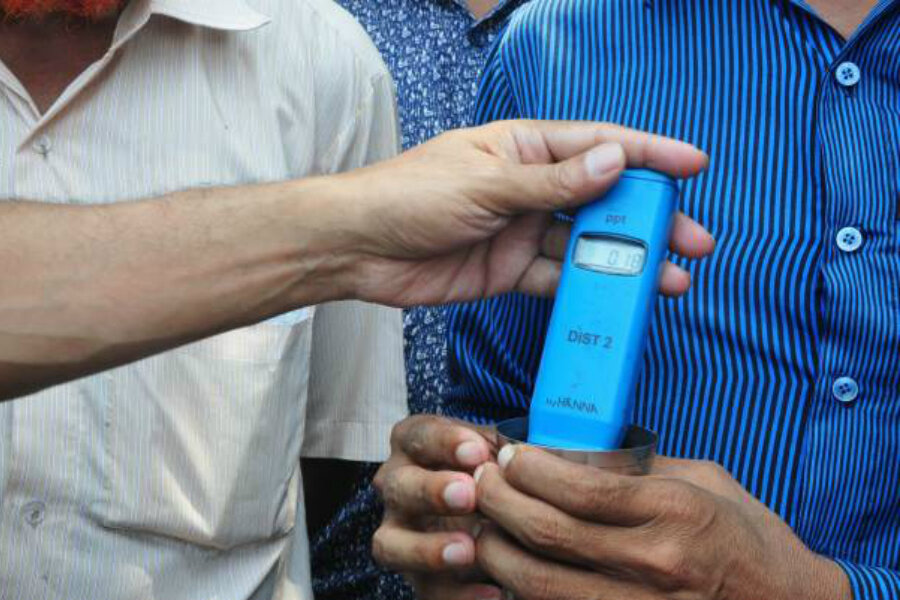Cheap, off-the-shelf technology cuts climate losses in Bangladesh
Loading...
| CHENCHURI, Bangladesh
Every day without fail Munsheer Suleiman, 69, follows the same ritual. He dips a small cup into the stream that flows through his village of Chenchuri, about 300 kilometers (186 miles) southwest of Dhaka, Bangladesh, and uses a light blue salinity monitor to measure the salt level in the water.
If Suleiman, who heads the village water-operating committee, is unable to take the measurements, he makes sure someone does it on his behalf. The reading is essential to the health of Chenchuri's crops, telling the community if the water is safe to use that day.
"Depending on the salinity level we decide whether to open the gates of the small dam that distributes water to the village," Suleiman said.
In 2009, deadly Cyclone Aila swept seawater into southwest Bangladesh's fields and freshwater, leaving salinity levels so high that farmers found themselves struggling to grow crops.
Three years later, the Bangladesh government, the Netherlands, and the Asian Development Bank (ADB) together launched a $43 million program to rehabilitate the waterways in Chenchuri and nearby Narail district.
The project included rebuilding 22 kilometers (14 miles) of riverbank, rehabilitating 257 kilometers (160 miles) of canals, building and repairing bridges, and improving irrigation systems.
Chenchuri's small dam was repaired to allow control of the water flowing from the much larger Chitra River. And the village committee was given the responsibility of opening and closing the dam gates, based on the daily readout from a simple salinity monitor.
Experts in Bangladesh say that, as cases like Chenchuri's show, big climate resilience projects can save communities from the effects of weather disasters – but only if the projects are run hand-in-hand with local know-how and make use of cheap, off-the-shelf technology.
Nazma Begam, whose family's paddy rice fields rely on the water flowing through Chenchuri dam, said her crop output has increased four-fold since the village starting using the dam and the salinity monitor two and half years ago.
The multimillion-dollar investment improved Chenchuri's dam system, but it only works because a $50 salinity monitor allows the villagers to make good day-to-day decisions, said regional water engineer Masud Karim.
"Salinity can really harm the crops, so when the villagers know the levels are high, they keep the gates shut and their crops safe," Karim said.
Chenchuri residents use their mobile phones to communicate with the water committee about their water needs. "When we need water we phone the water committee and, if there is agreement, we get water within hours," said farmer Begam.
According to Karim, before the dam's rehabilitation, villagers had to send requests for water to government officials about 100 kilometers (62 miles) away, and the opening or closing of the dam would take 48 hours to come into effect.
Water users also use their phones "to keep in touch with others upstream to get an idea of water levels, especially during the monsoon or heavy storms," Suleiman said.
In the village of Boyarshing, about 100 kilometers south of Chenchuri in Satkhira District, another merging of technologies is helping keep residents safe from extreme weather.
Villagers use a combination of an internet-connected computer, a manually operated weatherboard, and mobile phones to stay up to date on the area's increasingly erratic weather.
A computer at the village's main government office feeds weather bulletins to officials who use it to update the weatherboard with color-coded warning levels that are easily understood by villagers.
They then spread the information around their communities. "If we had something like this when Typhoon Aila came, if we had this kind of a warning system, it could have saved many more lives," said villager Anzar Ali.
Afrif Mohammad Faisal, ADB's environmental specialist in Bangladesh, said as rural communities come to recognize the severity of changing climate patterns, inexpensive technology has helped them become better prepared.
"It is about people understanding the threat levels, gaining up-to-date information and using it within their communities," he said. "The hardest job is to initially convince them that all of us need to change the way we react to weather."
Water engineer Karim says that villagers in Chenchuri were at first skeptical about the usefulness of the salinity monitor. Government officials spent several days with village communities building awareness of the benefits of using the monitor alongside the rehabilitated dam.
"Initially we were the ones doing the salinity monitoring. But after the harvest went up when we moderated water flow, depending on the salt levels, villagers figured out the importance," he said. "Now they even have a backup monitor, in case the one in use fails."
• Reporting by Amantha Perera; editing by Jumana Farouky and Laurie Goering. This story originally appeared at the website of the Thomson Reuters Foundation, the charitable arm of Thomson Reuters that covers humanitarian news, climate change, women's rights, trafficking, and corruption. Visit www.trust.org/climate.





